#Lisowicia bojani
Text

Lisowicia bojani was a giant dicynodont from the Late Triassic of Poland. Dicynodonts belonged to the group known as therapsids, a group of synapsid stem-mammals that flourished in the Permian period but was devastated in the end-period extinction event (aka the Great Dying). However, some therapsid groups rebounded in the Triassic, including dicynodonts like Lystrosaurus and the elephant-sized Lisowicia, and the cynodont ancestors of modern mammals.
7 notes
·
View notes
Text
Lisowicia bojani
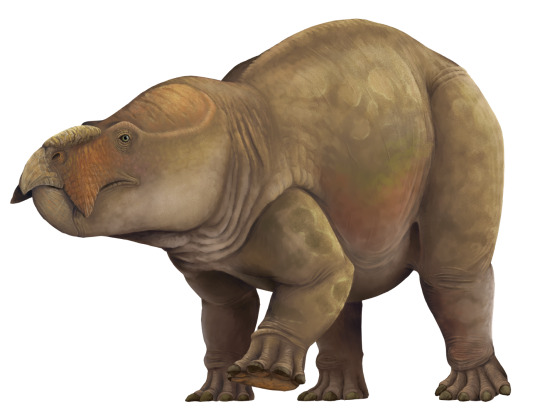
By Scott Reid
Etymology: From Lisowice
First Described By: Sulej & Niedźwiedzki, 2019
Classification: Biota, Archaea, Proteoarchaeota, Asgardarchaeota, Eukaryota, Neokaryota, Scotokaryota Opimoda, Podiata, Amorphea, Obazoa, Opisthokonta, Holozoa, Filozoa, Choanozoa, Animalia, Eumetazoa, Parahoxozoa, Bilateria, Nephrozoa, Deuterostomia, Chordata, Olfactores, Vertebrata, Craniata, Gnathostomata, Eugnathostomata, Osteichthyes, Sarcopterygii, Rhipidistia, Tetrapodomorpha, Eotetrapodiformes, Elpistostegalia, Stegocephalia, Tetrapoda, Reptiliomorpha, Amniota, Synapsida, Eupelycosauria, Sphenacodontia, Sphenacodontoidea, Therapsida, Eutherapsida, Neotherapsida, Anomodontia, Chainosauria, Dicynodontia, Therochelonia, Bidentalia, Dicynodontoidea, Kannemeyeriiformes, Stahleckeriidae, Placeriinae
Status: Extinct
Time and Place: Approximately between 208 to 215 million years ago, in the late Norian to possibly the earliest Rhaetian of the Late Triassic
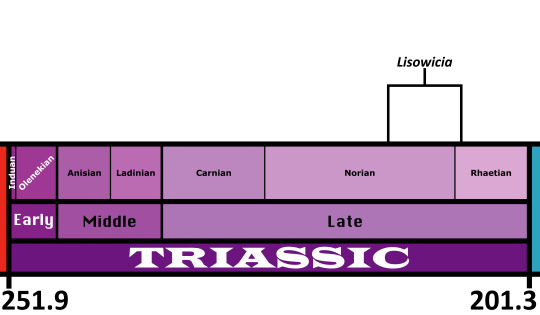
Lisowicia is known from the Lipie Śląskie clay−pit near Lisowice, Poland, as well as possibly other coeval sites in Poland

Physical Description: Lisowicia was a very large dicynodont. In fact, with an estimated length of more than 4 metres, a hip height over 2 metres, and an average body weight of 5.88 tons (and possibly up to 7 tons), it was the largest non-mammalian synapsid period, and would be the largest synapsids would ever grow to until the Eocene after the non-avian dinosaurs died out. By and large (ha!), Lisowicia resembles other closely related Triassic dicynodonts like Placerias; it was heavily built with a large barrel-shaped torso and short, stocky legs, a short stubby tail and a large head with a relatively long snout and a tortoise-like beak. Lisowicia was apparently tuskless, like some other Triassic dicynodonts, meaning that it was entirely toothless.
Lisowicia is not only distinctive for its massive size, but also for the design of its limbs. Most dicynodonts had either fully sprawled limbs, or upright hindlimbs and sprawling forelimbs as is the case for larger dicynodonts. Uniquely for dicynodonts, and for any stem-mammal for that matter, Lisowicia had an entirely upright stance with all four limbs being fully erect, holding them directly under its body and swinging them forwards and backwards when moving, like the legs of modern large mammals and dinosaurs. These column-like limbs are no doubt an adaptation for growing to such a massive size, as such limbs are necessary to support large body sizes in land animals, and in the Late Triassic only some sauropodomorph dinosaurs rivalled it in size. This involved not only changes to the orientation of the forelimb, but also changes to the shoulders, shortening of the forearm, and completely rearranging the musculature of the forelimbs in a way no other dicynodont is known to have done. Based on the footprints of other related dicynodonts, the feet of Lisowicia would have been very elephantine in appearance. Like elephants, they would have walked on the tips of the toes with a large fleshy pad underneath the heel to cushion the feet and support its weight. Basically, almost everything about Lisowicia was built to support a massive body size.
The outside appearance of Lisowicia is unknown, and the appearance of most stem-mammals in general is poorly understood. It’s possible it was covered in scales, had naked skin, or even hair, or maybe it had some other unknown structures. If it was anything like large herbivorous dinosaurs and mammals though, it may have been mostly naked anyways.
Diet: Lisowicia was a herbivore, browsing on low and mid-level vegetation using its long snout and toothless beak to crop and chew plants. Remarkably, coprolites attributed to Lisowicia can tell us what they were eating! Lisowicia appears to have mostly preferred eating softer vegetation, along with conifers, and in some cases they even supplemented it with pieces of wood! It’s possible this was a seasonal thing, feeding on tougher, fibrous vegetation during harder times.
Behavior: Like other large herbivores, Lisowicia may have been a herd animal based on fossil sites with multiple individuals preserved together, including adults and juveniles mixed together. Whether this means Lisowicia practised parental care is uncertain though, as it is with most other stem-mammals. Stem-mammal reproduction is poorly understood, but it’s at least probable that they laid eggs, and that includes Lisowicia. Other possible line of evidence for Lisowicia being social could be that they congregated in a specific place to defecate, called communal latrines. Hundreds of coprolites are known from where Lisowicia was first found, and other dicynodonts like Dinodontosaurus are known to have performed similar behaviour, so it’s possible Lisowicia did this too.
Ecosystem: The ecosystem in Late Triassic Poland is rather unusual, as it includes a mix of plants and animals that make it difficult to pin down just how old it really was. Some suggest an older Norian age, others seem more like they’re from younger Rhaetian ecosystems, and it’s still a bit of a mystery to what was going on in this environment compared to the rest of Europe at the time. In any case, the environment where Lisowicia was found was fairly wet and lush, an “everglades-like” swamp dominated by several types of conifers, alongside gingkos, cycads, seed ferns and liverworts. Lisowicia was one of the most common animals in this environment, but it coexisted with a wide variety of other animals. One of the most notable is the predatory archosaur Smok. Smok was the arch predator in this ecosystem, and is known to have directly fed upon Lisowicia, although whether they were actively hunted by it or just scavenged upon is unknown. Smok was certainly capable of crushing even the heavyset bones of Lisowicia, with not only bite marks on its bones attributed to Smok but even broken shards of its bones identified in Smok coprolites! Other reptiles that coexisted with Lisowicia included pterosaurs, dinosauromorphs and predatory theropods similar to Coelophysis or Liliensternus, a small predatory crocodylomorph, and small diapsids, including a sphenodont (a tuatara relative), a possible archosauromorph, and even a possible choristodere. The only other synapsid around was the little mammaliaform cynodont Hallautherium, which was many times smaller than the gigantic Lisowicia. There were also temnospondyl amphibians, including a large predatory capitosaur and a small plagiosaur (one of those very flat temnospondyls with the wide heads), as well as lungfish, coelacanths and even a hybodont shark. Notably, there are no sauropodomorphs known from this ecosystem, even though they were clearly already present in Europe at this time (e.g. Plateosaurus). It’s possible that Lisowicia occupied their role as a giant herbivore in their absence, although whether it had outcompeted them or just happened to live in a habitat without sauropodomorphs and got big is yet another mystery.
Other: In addition to achieving a size and stature amongst synapsids that wouldn’t be seen again until the mammals radiated during the Cenozoic, Lisowicia was also unique for how it grew. While some stem-mammals are known to have grown rapidly as young juveniles, Lisowicia is the only one known so far to never slow down its growth rate at all until adulthood. This type of continuous rapid growth is well known in dinosaurs and mammals, but is unique to Lisowicia amongst dicynodonts. Lisowicia is one of the most unique dicynodonts ever discovered, both as the largest and one of the most derived. It was also sadly one of the last. The cause of its—and all the other Late Triassic dicynodonts’—extinction is unknown, although it was probably a victim of the end-Triassic extinction event like so many other prominent Triassic animals. Late Triassic dicynodonts were once thought to be geographically restricted, left-over relicts from the past that eventually just fizzled away as “more advanced” animals pushed them out. But now we know that they were still globally widespread even in the latest Triassic, including in Europe with advanced forms like Lisowicia. Competition with sauropodomorphs was suspected, but the discovery of the related dicynodont Pentasaurus coexisting with sauropodomorphs in South Africa suggests they were capable of at least living together, and Lisowicia is proof dicynodonts could achieve similarly gigantic proportions. Ultimately, the extinction of the dicynodonts is a mystery, but Lisowicia shows that they were still getting bigger and better than ever, even at the end of their dynasty.
~ By Scott Reid
Sources under the Cut
Bajdek, P., Owocki, K. and Niedźwiedzki, G., 2014. Putative dicynodont coprolites from the Upper Triassic of Poland. Palaeogeography, Palaeoclimatology, Palaeoecology, 411, pp.1-17
Dzik, Jerzy; Sulej, Tomasz; Niedźwiedzki, Grzegorz (2008). "A Dicynodont-Theropod Association in the Latest Triassic of Poland". Acta Palaeontologica Polonica. 53 (4): 733–738
Fiorelli, L.E., Ezcurra, M.D., Hechenleitner, E.M., Argañaraz, E., Taborda, J.R., Trotteyn, M.J., Von Baczko, M.B. and Desojo, J.B., 2013. The oldest known communal latrines provide evidence of gregarism in Triassic megaherbivores. Scientific reports, 3, p.3348
Kowal-Linka, M., Krzemińska, E. and Czupyt, Z., 2019. The youngest detrital zircons from the Upper Triassic Lipie Śląskie (Lisowice) continental deposits (Poland): Implications for the maximum depositional age of the Lisowice bone-bearing horizon. Palaeogeography, palaeoclimatology, palaeoecology, 514, pp.487-501
NIEDŹWIEDZKI, G., GORZELAK, P. and Sulej, T., 2011. Bite traces on dicynodont bones and the early evolution of large terrestrial predators. Lethaia, 44(1), pp.87-92
Romano, Marco; Manucci, Fabio (14 June 2019). "Resizing Lisowicia bojani: volumetric body mass estimate and 3D reconstruction of the giant Late Triassic dicynodont". Historical Biology. 0: 1–6
Qvarnström, Martin; Ahlberg, Per E.; Niedźwiedzki, Grzegorz (2019). "Tyrannosaurid-like osteophagy by a Triassic archosaur". Scientific Reports. 9
Sulej, T., Bronowicz, R., Tałanda, M. and Niedźwiedzki, G., 2010. A new dicynodont–archosaur assemblage from the Late Triassic (Carnian) of Poland. Earth and Environmental Science Transactions of the Royal Society of Edinburgh, 101(3-4), pp.261-269
Sulej, T. and Niedźwiedzki, G., 2019. An elephant-sized Late Triassic synapsid with erect limbs. Science, 363(6422), pp.78-80
Świło, M., Niedźwiedzki, G. and Sulej, T., 2013. Mammal-like tooth from the Upper Triassic of Poland. Acta Palaeontologica Polonica, 59(4), pp.815-821
#Lisowicia#Dicynodont#Triassic March Madness#Palaeoblr#Synapsid#Lisowicia bojani#Triassic Madness#Prehistory#Paleontology#Prehistoric life#Mammal-like reptile#Stem mammal
218 notes
·
View notes
Text
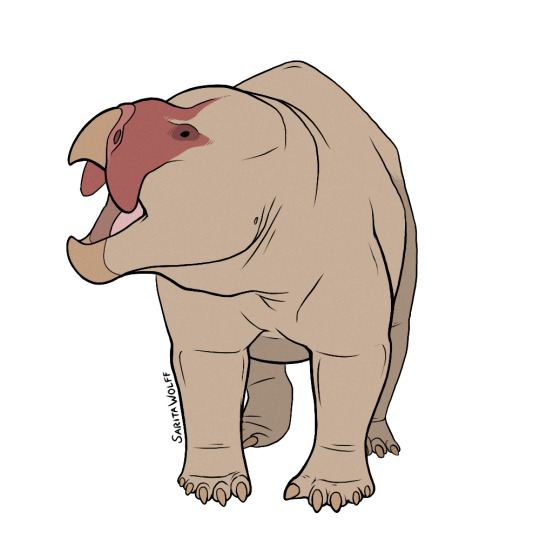
The largest dicynodont species (that we know of) was Lisowicia bojani. Found in Poland and hailing from the Late Triassic, it was about the size of an Asian elephant and estimated to have weighed between 5 and 6 tons. Rather than tusks, it had these weird bony protrusions on either side of its face. It was even more unique in that it stood in an erect posture, rather than with its legs sprawled to the side like other dicynodonts, probably due to its weight. It may have been a high-browsing competitor to early sauropodomorphs, and was preyed upon by the mysterious predatory archosaur Smok.
5 notes
·
View notes
Text
It’s finally Triassic March Madness, which means i will be doing nothing but rooting for the big lad Lisowicia for the rest of the month
57 notes
·
View notes
Photo
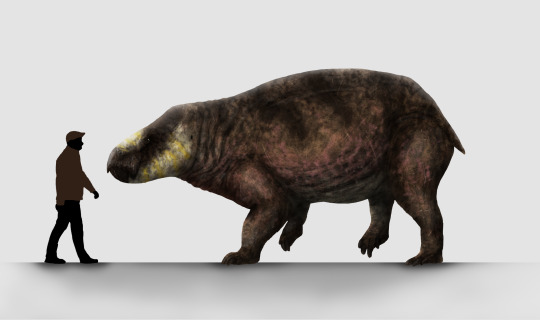
A quick study of the giant Triassic dicynodont Lisowicia bojani.
My first dicynodont drawing and what better start than this Polish giant?
#my art#paleoart#triassic#animal#lisowicia#dicynodont#extinct#nature#sciart#paleontology#poland#therapsida#herbivore#mesozoic
54 notes
·
View notes
Photo
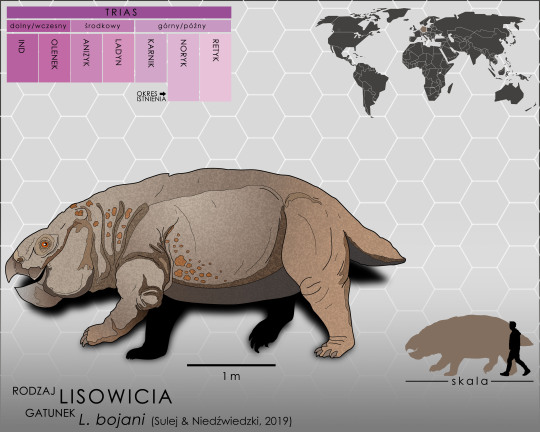
Lisowicia bojani
Rodzina - Stahleckeriidae
🇵🇱 Lisowicia to wymarły rodzaj gigantycznego synapsyda z infrarzędu dicynodontów, który żył na terenach dzisiejszej Polski z późnego triasu. Lisowicia jest największym znanym dicynodontem, a także największym synapsydem nie będącym ssakiem. Szacuje się, że ważyła od 5 do 6 ton, co jest porównywalne pod względem wielkości do współczesnych słoni.
🇺🇸 Lisowicia is an extinct genus of giant dicynodont synapsid that lived in what is now Poland during the late Norian or earliest Rhaetian age of the Late Triassic Period. Lisowicia is the largest known dicynodont, as well as the largest non-mammalian synapsid, and is estimated to have weighed between 5–6 tons, comparable in size to modern elephants.
#Lisowiciabojani#Placeriinae#Lisowicia#Stahleckeriidae#Therapsida#Dicynodontia#LateTriassic#Norian#Triassic#doodlies#paleoart#speculation#monster#pola negri#concrete polishing#monsteranimal#digitalart#reconstruction#dinoart#dinosaur#digitaldrawing
4 notes
·
View notes
Photo
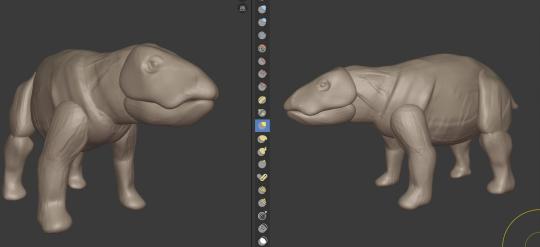

Speed sculpts June 10th & 11th
1. Lisowicia bojani
2. Lystrosaurus sp.
I decided to go from 35 minutes of sculpting to 45 minutes because I want to tackle more intricate forms / details. Lisowicia was the last sculpt done within 35 minutes.
#lisowicia#Lystrosaurus#dicynodont#therapsid#synapsid#permian#speedsculpt#sculpting#practice#blender3d#blender#3D#3D art#digitalart#paleoart#animalart#art#myart#my3d
18 notes
·
View notes
Photo
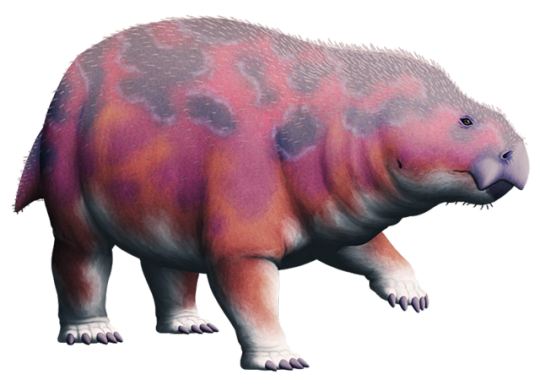
Dicynodonts were a group of herbivorous animals with toothless beaks and protruding tusks, part of the synapsid lineage and much closer related to mammals than to reptiles. They were some of the most successful and widespread land vertebrates from the Late Permian to the Middle Triassic, with one genus even briefly taking over the world in the aftermath of the End-Permian mass extinction event.
And it turns out some of them got very big.
Fossils of a surprisingly large dicynodont were first reported in 2008, but it wasn’t until just recently in late 2018 that this giant creature was finally given an official name -- Lisowicia bojani.
Close in size to a modern elephant, at around 2.6m tall (8′6″) and 4.5m long (14′9″), it was by far the largest known example of its kind to have ever lived. And while most other dicynodonts had upright hindlimbs and sprawling forelimbs, Lisowicia seems to have developed a fully upright posture much more similar to that of quadrupedal dinosaurs and modern mammals.
It was also one of the very last of its kind, living during the Late Triassic of Poland, about 208 million years ago (although there was a possible later survivor in Australia). This was around the same time that early sauropod dinosaurs were likewise first starting to experiment with gigantism, suggesting that both groups were convergently evolving to exploit newly-available ecological niches.
#science illustration#paleontology#paleoart#palaeoblr#lisowicia#synapsid#dicynodont#stahleckeriidae#kannemeyeriiformes#anomodontia#therapsid#stem-mammals#art#speculative fluffiness#stop shrink-wrapping synapsids#big friend
728 notes
·
View notes
Link

An article published in the journal "Science" reports the description of Lisowicia bojani, an animal belonging to the group of dicynodonts that lived in today's Poland during the Upper Triassic period. Tomasz Sulej of the Institute of Paleobiology of the Polish Academy of Sciences and Grzegorz Niedzwiedzki of the Department of Organismal Biology of the Swedish University of Uppsala studied this elephant-sized animal that contradicts the idea that at the time big herbivores were all dinosaurs.
0 notes
Photo

Introducing an Elephant-sized Late Triassic Synapsid With Erect Limbs
Tomasz Sulej, Grzegorz Niedźwiedzki
Vol. 363, Issue 6422, pp. 78-80
DOI: 10.1126/science.aal4853
A proto-mammalian giant
Early terrestrial amniotes evolved into two groups: the sauropsids, which led to the bird and dinosaur lineages, and the synapsids, which led to mammals. Synapsids were diverse during the Permian but were greatly reduced after the end-Permian extinction (about 252 million years ago). The few groups that survived into the Triassic were mostly small and retained a sprawling gait. Sulej and Niedźwiedzki, however, describe a dicynodont from the Late Triassic of Poland that is as large as some coexisting dinosaurs and appears to have had an erect gait—like modern mammals. Thus, megaherbivores in the Triassic were not only dinosaurs.
Abstract
Here, we describe the dicynodont Lisowicia bojani, from the Late Triassic of Poland, a gigantic synapsid with seemingly upright subcursorial limbs that reached an estimated length of more than 4.5 meters, height of 2.6 meters, and body mass of 9 tons. Lisowicia is the youngest undisputed dicynodont and the largest nondinosaurian terrestrial tetrapod from the Triassic. The lack of lines of arrested growth and the highly remodeled cortex of its limb bones suggest permanently rapid growth and recalls that of dinosaurs and mammals. The discovery of Lisowicia overturns the established picture of the Triassic megaherbivore radiation as a phenomenon restricted to dinosaurs and shows that stem-group mammals were capable of reaching body sizes that were not attained again in mammalian evolution until the latest Eocene.
Read the paper here.
27 notes
·
View notes
Photo
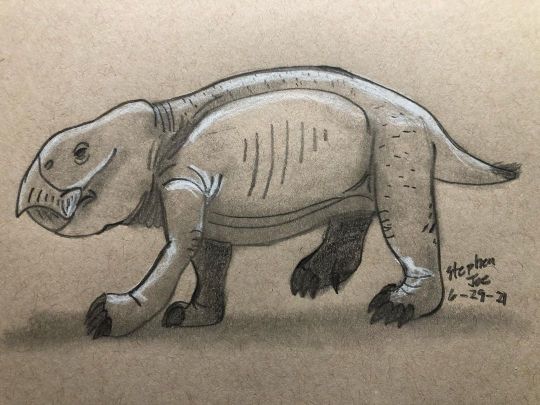
The final days of #SynapsidWeek is none other than giant Dicynodontia called Lisowicia bojani, which is the last of late surviving synapsid that lived in the late Triassic, the dawning new era of primitive dinosaurs and other animals of Triassic, which give rise of the primitive mammals as well. #paleoart #synapsidjune #paleothemeweek #artistsoninstagram #sketchbook #tonedtan #tonedtanpaper #tonedtansketchbook #tonedtanart #tonedtanpaperdrawing #lisowicia #lisowiciabojani #dicynodont #triassic #triassicperiod #latetriassic #latetriassicperiod #myart https://www.instagram.com/p/CQv483ClWyJ/?utm_medium=tumblr
#synapsidweek#paleoart#synapsidjune#paleothemeweek#artistsoninstagram#sketchbook#tonedtan#tonedtanpaper#tonedtansketchbook#tonedtanart#tonedtanpaperdrawing#lisowicia#lisowiciabojani#dicynodont#triassic#triassicperiod#latetriassic#latetriassicperiod#myart
0 notes
Text
Move Over Woolly Mammoth - There is a New Giant Dinosaur that Roamed the (Triassic) Earth!

A brand-new type of gigantic ancient herbivore would have eclipsed its family members!!
Fossils discovered in Poland come from a previously undiscovered species from the Triassic period, some 237 million to 201 million years back, scientists report. But unlike the majority of the huge animals who lived throughout that era, this brand-new animal isn’t a dinosaur– it’s a dicynodont.
Dicynodonts are a group of ancient four-legged animals that are related to mammals’ ancestors. They’re a varied group, however, the brand-new species is far bigger than any other dicynodont discovered to date. The elephant-sized animal was more than 4.5 meters long and most likely weighed about 9 tons, the researchers estimate. Related animals didn’t end up being that huge again up until the Eocene, 150 million years later.
“We think it’s one of the most unexpected fossil discoveries from the Triassic of Europe,” states research study coauthor Grzegorz Niedzwiedzki, a paleontologist at Uppsala University inSweden “Who would have ever thought that there is a fossil record of such a giant, elephant-sized mammal cousin in this part of the world?” He and his group initially described a few of the bones in 2008; now they have actually made the brand-new types—Lisowicia bojani — official!
The animal had upright forelimbs like today’s rhinoceroses and hippos, rather of the splayed front limbs seen on other Triassic dicynodonts, which resembled the forelimbs of contemporary lizards. That posture would have assisted it to support its huge bodyweight.
“The discovery of Lisowicia changes our ideas about the latest history of dicynodonts, mammal Triassic relatives. It also raises far more questions about what really makes them and dinosaurs so large,” says Dr Tomasz Sulej, Polish Academy of Sciences.
This provides the first evidence that mammal-like elephant-sized dicynodonts were present at the same time as the more well-known long-necked sauropodomorph dinosaurs, countering the previously-held belief. Sauropodomorphs include species like the Brachiosaurus and Diplodocus. It fills a void in the fossil record of dicynodonts and it also it shows that some anatomical features of limbs thought to characterize large dinosaurs evolved also in the non-mammalian synapsid.
Most exciting of all; these findings from Poland are the first genuinely substantial discovery of dicynodonts from the Late Triassic Period, found in Europe.
New post published on: https://www.livescience.tech/2018/11/26/move-over-woolly-mammoth-there-is-a-new-giant-dinosaur-that-roamed-the-triassic-earth/
0 notes
Text
Descubierto un gigantesco antepasado de los mamíferos
El descubrimiento reciente en Polonia de un enorme cuadrúpedo denominado Lisowicia bojani, del Triásico superior, revoca la opinión de que los únicos herbívoros gigantes que vagaron por las tierras triásicas fueron dinosaurios.
etiquetas: paleontología, triásico, dicinodontes, mamíferos, dinosaurios
» noticia original (www.agenciasinc.es)
0 notes
Text
An Elephant-Size Relative of Mammals That Grazed Alongside Dinosaurs
An Elephant-Size Relative of Mammals That Grazed Alongside Dinosaurs
Paleontologists believed dicynodonts died out as dinosaurs conquered the world, but fossils found in Poland suggest they survived millions of years more.
An artist’s reconstruction of Lisowicia bojani, a new species of dicynodont found in a clay pit in Poland.Credit Credit Karolina Suchan-Okulska
By Nicholas St. Fleur
You can call it a Triassic titan. Or a pre-Jurassic juggernaut.…
View On WordPress
0 notes
Link
Scientists Have Discovered The Remains Of An Enormous Plant-Eating Creature That Lived 200 Million Years Ago Yahoo News
The remains of an enormous plant-eating dicynodont creature called Lisowicia bojani were recently discovered in Poland — and scientists believe that this ...
0 notes